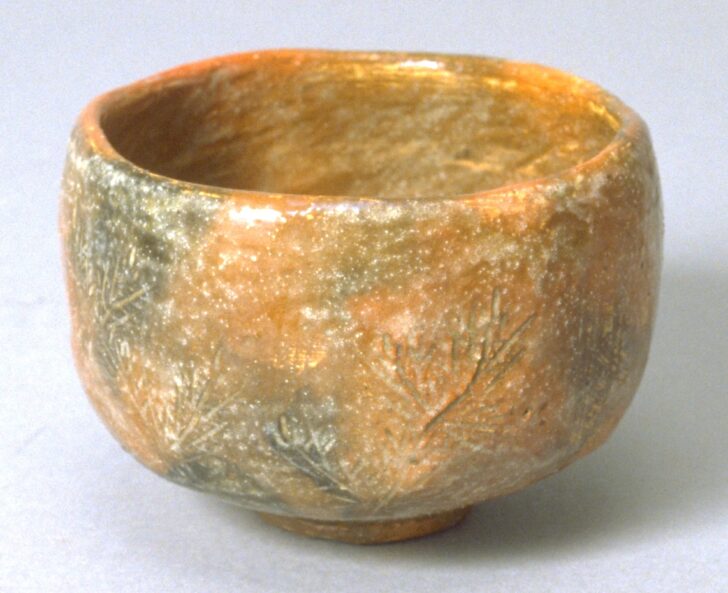Red Raku ware tea bowl with imprinted leaf designs
Raku Tan'nyū

Description
Sen no Rikyû (1522–1591), tea master to Japan’s most powerful warlords in the late sixteenth century, championed the use of humble materials in the tea ceremony. Instead of expensive imported Chinese celadon or bronze flower vases, for example, he carved his own from bamboo in his own garden. Rikyû encouraged the Kyoto potter Chôjirô (1515–1592) to develop a new type of tea bowl, known as raku ware, formed by hand and fired in a simple, pit-like chamber. Chôjirô’s distinctive, thick-walled tea bowls set the standard for works by later generations of the Raku family, such as this tea bowl and UMMA 2000/1.30.
Over the centuries, three lines of tea schools directly descended from Sen no Rikyû. The successive heads of these three families often would hand-form their own tea bowls, which would then be glazed and fired by the then head of the Raku family. For an example of such a tea bowl, please see UMMA 1963/2.71, which is attributed to Sen Sôshu X, the tenth generation head of the Mushanokoji School of Tea.
From "Silk Road to Clipper Ship: Trade, Changing Markets, and East Asian Ceramics."
exhibited summer 2010
---
Raku Tan’nyû
Japan, 1795–1854
Red Raku ware tea bowl with stamped leaf designs
Edo period (1615–1868)
1820s–40s
Earthernware with red and gray glaze
Bequest of Margaret Watson Parker, 1954/1.537
Sen Rikyû (1522–1591), tea master to Japan’s most powerful warlords in the late sixteenth century, championed the use of humble materials in the tea ceremony. Instead of expensive imported Chinese celadon or bronze flower vases, for example, he carved his own vase from bamboo in his garden. Rikyû encouraged the Kyoto potter Chôjirô (1515–1592) to develop a new type of tea bowl, known as Raku ware, formed by hand and fired in a simple, pit-like chamber. Chôjirô’s distinctive, thick-walled tea bowls set the standard for works by later generations of the Raku family lineage of tea wares, such as this bowl.
(6/28/10)
Subject Matter:
Sen no Rikyû (1522–1591), tea master to Japan’s most powerful warlords in the late sixteenth century, championed the use of humble materials in the tea ceremony. Instead of expensive imported Chinese celadon or bronze flower vases, for example, he carved his own from bamboo in his own garden. Rikyû encouraged the Kyoto potter Chôjirô (1515–1592) to develop a new type of tea bowl, known as raku ware, formed by hand and fired in a simple, pit-like chamber. Chôjirô’s distinctive, thick-walled tea bowls set the standard for works by later generations of the Raku family, such as this tea bowl.
Physical Description:
This rustic, earth tone ceramic tea bowl has a rough, natural feeling texture. Impressed into the outer sides of the tea bowl are the imprints of pine needles.
Usage Rights:
If you are interested in using an image for a publication, please visit https://umma.umich.edu/request-image/ for more information and to fill out the online Image Rights and Reproductions Request Form.